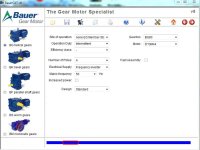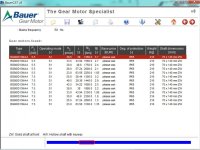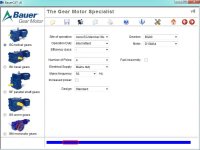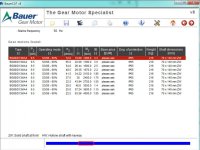Hi all,
I have some questions about gear-motors and I hope you can help me to find their answers. We use some of Bauer gear-motor products in our factory for many years. Recently we need to change the application of a BG80/D13MA4 to hoist application, driven by an inverter.
I have some questions about gear-motors and I hope you can help me to find their answers. We use some of Bauer gear-motor products in our factory for many years. Recently we need to change the application of a BG80/D13MA4 to hoist application, driven by an inverter.
On the nameplate of the motor, the following data are written:
P=7.5 kW
n2=65 rpm
n1=1420 rpm
I=15.8 A
PF=0.85
f=50 Hz
P=7.5 kW
n2=65 rpm
n1=1420 rpm
I=15.8 A
PF=0.85
f=50 Hz
According to above data the gear ratio should be approximately 21.85. But in Bauer-CAT software, when I chose the above gear-motor (attached file "1.jpg") and click on the next screen button, it showed me a table with 13 rows of configuration (attached file "2.jpg"). Strangely, the gear ratio of SAME gear is changing, from 26 to 63. As far as I know, the gear ratio of the gear is always constant!!
Next, I changed the electrical supply combo-box to "mains duty" (attached file "3.jpg") and click on next screen button. The new table of configuration has 10 rows and in the P2 column, the value of 9.5 kW is written (attached file "4.jpg"). The hoist application is not S1 (continuous) type and in fact it is S3/S6 one.
The abovementioned scenario raised following questions in my mind that I want you to help me to find their answers, please:
1. Why there is numerous "gear ratio" for a single gear?
2. Why there is 5.5 kW configuration, even when I chose 7.5 kW motor type?
3. Which of reported torques is correct to assume for the hoist application?
4. We want to use a 7.5 kW inverter to drive the gear-motor of the hoist (the stated power rating on the motor nameplate). Should we use a 9.5 kW instead, if the data of the software was correct?
1. Why there is numerous "gear ratio" for a single gear?
2. Why there is 5.5 kW configuration, even when I chose 7.5 kW motor type?
3. Which of reported torques is correct to assume for the hoist application?
4. We want to use a 7.5 kW inverter to drive the gear-motor of the hoist (the stated power rating on the motor nameplate). Should we use a 9.5 kW instead, if the data of the software was correct?
Thank you.






